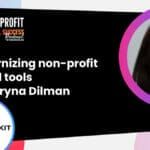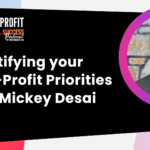Video recording
Audio recording
Join us as we explore the nuanced world of leadership within the non-profit sector. Anthony, a seasoned consultant from 180 Management Group, shares his knowledge of fostering a creative culture that thrives on collaboration and innovation.
Whether you’re struggling with tight deadlines or looking to inspire your team to new heights of creativity, this episode is packed with actionable insights.
Tune in to learn how you can lead your marketing team not just to meet but exceed their goals, all while nurturing the creative spark that drives your mission forward.
Mentioned Resources
Episode Transcription
David Pisarek: Want to master the art of managing creatives amidst tight deadlines, fostering a creative culture, understanding the needs of designers and copywriters, and uncovering common leadership missteps? Discover all this and more in today’s episode.
Welcome to the Non-Profit Digital Success Podcast. I’m your host, David, and in this episode, we’re going to be talking all things marketing leadership with Anthony A. Dicks. Anthony is a seasoned leadership expert with over two decades of experience mentoring non-profit leaders. As a senior leadership consultant for 180 Management Group, he passionately guides individuals to unlock their full leadership potential. Anthony, thank you so much for joining us on the episode today.
Anthony A. Dicks: David, it’s great to be here and thank you for that unsolicited yet amazing introduction. I was looking for the guy you were introducing, but I realized that it was me. Thank you. Thank you so very much for having me.
David Pisarek: And he’s humble. We were talking just before the show. You’ve got a couple of children. They’re a little bit older than mine. How is it that you can do the work you’re doing and support your family and their growth?
Anthony A. Dicks: Well, I’m a man of faith, so I first say this, but by the grace of God, actually, we’re extremely fortunate to have the opportunity to raise such wonderful children.
Funny enough, this podcast has something to do with managing creatives and marketing. It’s interesting with my children. One of them is a marketing major. Another one of them, my son, is an e-con major, but he has his own YouTube channel and he’s exploring videography and design and all of this stuff while doing the e-con stuff.
Then my youngest daughter started out as a marketing major and didn’t quite like it, but she went into public relations and journalism, which is a close cousin. Seeing the things that we have done here in our business at home really is reflective and how the children have grown and developed. It’s really, really funny. We’ve been graced, thankfully, to see them flourish educationally. Thanks for asking about that, that’s a good question.
David Pisarek: That’s amazing. Talking about fostering creativity, how can leaders foster a creative work environment for a culture where everybody’s rushing and hurrying, and they just want to get things done?
Anthony A. Dicks: Yeah, there are many options out there for people. But in a creative space, it’s hard to rush creativity.
When you rush creativity, it diminishes the product, it diminishes the outcomes, it diminishes the content.
And so for a creative to flourish, there has to be safe spaces for them to explore. But still, you really have to have very, not to overly use the word, creative systems for accountability as well. And there are some ways in which you can continue to slow things down so that creatives can flourish and still meet the deadlines. And one way to do it is just to be clear in what you expect.
Now, I’m pretty sure as you’ve gone about working with a client, it probably takes a good little while to get the client clear about what they actually want you to produce. They may be effective at casting vision; they may be effective at building other initiatives.
But when you start talking about stuff like flyers and social media campaigns or websites, it’s almost as if they turn into the Charlie Brown teacher. And you’re trying to pull certain things from them so that you can write the copy, trying to pull certain things from them so that you can design a website that aligns with their brand or just design whatever it is you’re designing that aligns with their brand, whether it’s a video, a video script or what have you.
And so a lack of clarity just clouds up the timeline. If we had clearer expectations and clearer demands, it would help to speed up the creative process while still providing enough space for people to be creative.
David Pisarek: I think that there are some excellent points there. Absolutely, Anthony. I think for myself when I was working in larger organizations, having time to just get together and have conversations and sit down and talk about a project and just forget about time, forget about money, forget about technical, potential problems or barriers to success.
What is the pie in the sky? What is it that we can do? And then go, “Okay, well, this is going to be a $200,000 three-year project. They have $5,000,” or it’s for a team in your organization that you’re working with, like volunteers or HR or who knows, whatever. What’s realistic? And then so you can take a look at this big, grandious, amazing idea and go, “Okay, we’re going to take this piece from it, and that’s what we’re going to do right now. Let’s not throw this in the garbage. Let’s keep this as a long-term plan and goal.”
Anthony A. Dicks: And providing those types of spaces give creatives an opportunity to draft. So you give them enough freedom to where outcomes are off the table at this point. “Let’s just brainstorm.” Brainstorming is a form of just drafting. Let our imaginations run the way that they run. And as professionals, we know we can’t do that all day.
You can’t draft and imagine and brainstorm for eight hours, but carve out a particular time in a project plan for drafting and brainstorming where there are rules on the table that no idea is off the table can give you the space just to get it all out.
And then, as any great sculptor would do, now that I’ve got all of the marble out of my mind, I can go back and chisel it to make it into a piece of art because restricting resources also helps to promote creativity. But it’s when those restrictions of resources become stressful that, that cortisol inoculates creativity. But as you said, creating those safe places in the project plan to go ahead and get all of the ideas out on the table to just do some drafting. We’re not critiquing anything.
David Pisarek: Let’s just get it all out is an excellent way to help creatives feel like work can be played because that’s what it is. I think we’re like creatives who have the best toys. We get all the electronics like IT. They are who they are, but they’re not necessarily marketers, graphic designers, copywriters. We’ve got the videography, we’ve got all of the other programs, Photoshop, InDesign. We got all of those software toys and hardware toys. If work should feel like play. One way to create that is to do exactly what you said to provide a space for brainstorming and drafting.
Something else that I think people should be aware of, if they’re not already aware, is creativity doesn’t just happen instantly. I’ve got my team behind me and helping me. And when we get together and do some brainstorming, it’s a good 10-15 minutes before we can actually really get in the zone of creative thought. And so booking a half hour time isn’t really enough. If anybody’s thinking about getting a team together, whether it’s virtual or in-person, it doesn’t really matter.
There are all kinds of online tools that you could use for documenting and whiteboarding and all that type of stuff. If you can do it in person, that’s my favourite way of doing it, have at least an hour, block off the time, and everybody can just forget about what they’re doing. Even if they’re not necessarily the most creative people, they might come up with a slogan or put some words together or an idea that they saw on some other website for inspiration.
Anthony A. Dicks: Exactly. And inspiration, to me, is, if not number one, high on the list of things that creatives need.
Creatives need inspiration. And one way to get that inspiration, of course, is through conversation and collaboration.
But another way, and often people don’t have a lot of latitude to make these adjustments, but I think they should at least consider it, is to look at the physical environment your creatives are working in. Is the physical environment stale, or is it stimulating? Is it going to stimulate inspiration, or are your creatives in cubicles? Are they looking at cinder blocks? What is it that they have in their physical work environment? Are the desks and workspaces arranged best for collaboration and conversation, or are they blocked and siloed off? Those are aspects of design that could help designers to foster that creative environment.
David Pisarek: Absolutely. And that leads into what I wanted to talk with you about next what are the ingredients of a healthy creative team culture and environment?
Anthony A. Dicks: Well, you alluded to a few of them already. One of them is collaboration. You have to be able to bounce ideas off of each other, off of someone else.
Creativity is done best as a team.
You can, of course, come up with ideas and things of that nature on your own. But because anything created is an art form, it’s going to be subject to critique. You want to project it to helpful, constructive feedback before it’s released to the public. And the way to do that is collaboratively. That’s what makes it constructive.
However, collaboration is facilitated by communication. So if you don’t have great or healthy team communication, then that’s not going to work either.
So you need that collaboration. You need that communication because those two things foster chemistry. That’s one of the major differences between the team and the group. A group doesn’t have chemistry.
David Pisarek: I love that idea about groups versus teams and collaboration as the differentiator between them. We can all do so much more if we’re working together cohesively for the ultimate goal. So being clear about here’s the objective, here’s what we need to achieve, here’s the timeline around that, obviously. We can’t do things that it’s going to take a year and a half when we need to do them in two months. But knowing what we’re aiming for and we’re all working together is better than people just going off on their own. Let’s talk about this for a second. Coming out of COVID, how have you seen the shift in being social through COVID, through the two and a half, three years of that?
Anthony A. Dicks: Well, there are challenges on both sides of the table when it comes to how COVID has influenced human behaviour, especially in this space, when we’re talking about creatives.
I’ve had conversations with people who lead marketing firms and have virtual employees and virtual team members. For some, they enjoy it. For others, they are pining about it because it seems to diminish the product. It really depends on the culture of the organization and how that culture fosters creativity best. There may be some who can foster it best virtually. There may be others who can foster it best in person, physically. It just really depends on the culture, the culture of the organization.
I do think that because of the technology that we have, it gives us those options. I have been able to develop strong relationships with people since COVID-19 that I have never met physically, never met them in my life. You can still brainstorm, and you can still have those creative juices flowing virtually. It just takes a commitment to do it that way. If you inherently think that doing it virtually is not the best way to do it, then virtually it will never work for you.
But if you have a space where you say, “Well, maybe this can work,” then you can at least explore it.
David Pisarek: I know sometimes, between creatives, things can maybe get a little heated because everybody has their own opinion, and this should be read. No, this should be marooned and conversations around that. Sometimes it could be difficult to manage creatives, whether they’re designers, copywriters, marketers, PR or media editorials. Why do you think it’s so challenging sometimes to manage creatives?
Anthony A. Dicks: I go back to what I said before. It’s challenging because given the context that you just laid out, like creatives having some tension and conflict about what’s best, what colour is best, what hue is best, what font is best, what word choice is best, all of those intricacies, when you critique (you can tell I’m a little creative on the inside) when you critique someone’s art because it came from a person, they take it personally, right? They take it personally.
And then, if this person has established a trend of successful outcomes, those statistics in their mind contribute to this not only being good art but also good science because it makes sense. The last time we had these colours, the last time we used this font, we had and such and such and so and so, and these were the outcomes. So, there’s scientific evidence to establish that this colour is the right colour to bring about this feeling from the person viewing it.
And so you get those two coupled together, you’re going to have some tight moments. And that’s just the nature, one, of the discipline and the profession that we have.
And two, that’s just the nature of people. If leaders of creatives remember that these are people, not just producers of products, but these are actual people.
People are complex, and you can manage their complexity with simplicity.
So if we set parameters for our conversations, if we set ground rules for how we engage each other when we critique each other’s art, it can help to provide a safe space. Think about it. When you are on the road, the highway system is simple. The drivers are complex. You don’t know what a person is going to do, but the thing that keeps me from running off the road is a little white line. You know what I’m saying? It’s simple. And so if we can, as leaders of creatives, create clear and simple systems, we can manage the complexity of those who are under our charge.
David Pisarek: Sometimes we get in the zone, is what I’m going to call it, and we’re very fixated on fixing a problem, whether it’s with words or design or programming or whatever.
Even if you’re a developer, you can still be creative in how you solve around solving X, Y, and Z. Whatever that is, we get in the zone, and we’re focused, and we’ve got our blinders on. It’s really hard to imagine that something could be done a different way. One isn’t necessarily better than the other.
There might be times when doing something a certain way is better because of what you want to do down the road. And if you’re stuck trying to solve this one thing, you might have forgotten or might not know about these longer-term pieces that also need to be brought into consideration.
And I think working with the team, other people can remind you of those types of things. The leadership really needs to be the GPS. They need to understand how fast the team is going and where they are headed. Being able to explain to the team, “All right, here’s where you got to turn left or turn right.” It’s able to navigate around obstacles like closed roads and things like that. I think it’s a really, really great analogy.
Anthony A. Dicks: And I would add to that, one of the practical ways in which you can provide that GPS, so to speak, is not just directionally, but also with a dashboard that gives you insight into the team’s capacity. On the dashboard in my vehicle, your vehicle, there are a whole lot of capacity measurements. How much gas is in the car? How fast are we going? How fast have we been travelling? And oil pressure and a whole host of other things so that we, even though we don’t have the technical expertise to build that dashboard, we do have the technical expertise to read it and govern ourselves accordingly.
And so marketing leaders should have some type of dashboard to help measure the creative’s capacity. Because if you pile several projects on a creative team, they may not be able to produce project Z with the same zeal as they do project A because they’re just at capacity. So helping to measure those things does arm, and again, that’s another simple system to help manage complex people. That’s another way in which we can provide leadership as a GPS or as a dashboard to keep us working at our optimal.
David Pisarek: We talked a lot so far in this episode, about being part of a creative team and how leaders can help manage, steer, and set up the team for success. Let’s talk about this from the client’s perspective.
So you’re an organization; you’re looking at hiring a creative team for whatever it happens to be. Maybe you want to rebrand, you hate your logo, or you hate your business or organization name, maybe you just need a website redesign, or you just have an annual report that you need to produce. Are there any tips that you have for people who might be considering working with a creative team?
Anthony A. Dicks: That’s an excellent question. If I were the client, I want the creative’s best. I’ve been on both sides of the table, providing some of the marketing deliverables. I have an executive certificate in digital marketing from E. Cornell, and I was at one time a story brand-certified guide. I don’t know if you know what a story brand is. Business made simple, Donald Miller. I did that for three or four years and was doing the marketing stuff from that. I’ve been on both sides of the table.
What I want from a client they don’t always provide does inhibit one’s ability to provide what the client wants—providing a space for the client and a potential firm to discover what they want.
That’s one way in which both the client and the marketing professional or firm can see if there’s chemistry.
I know this might be a lot to ask, but you can sense it when the vendor, the firm or the professional gets you. You can feel it.
Trying to engage as much of your heart in the engagement as you do your head is necessary because you can get a lot further with the firm if you’ve got a good relationship upfront.
That discovery call or those initial consultations can help you to see whether or not this is a person who we can work with. Because when they give you a piece of art, and it doesn’t meet your expectations, you’ve got to revise it. In the revision stage, you don’t want there to be a lot of conflict or miscommunication people to take things personally or something else to come up. Creating that connection and sensing chemistry is one tip that I would give.
David Pisarek: What I heard from what you said there is to allow yourself enough time in the project timeline to be able to establish a relationship with the company.
A lot of times, in my experience, organizations are at the last minute going, “Oh, we need to do this. We need it in the next month.” And so they’re rushing. There isn’t enough time to really establish the relationship to really understand their visceral gut reaction to a company like yours or mine or others to go, “You know what? This is the right fit for us.”
Anthony A. Dicks: It’s unfortunate that for some non-profit organizations, they have a tendency to stand or stay behind the operational eight ball. There’s always a press that makes it difficult to prioritize projects because everything seems to be urgent.
You get a last-minute grant that you want to have, or you find out that there were some stipulations in the grant that change how you need to present something in the annual report, and you’ve already printed it, and you’ve already designed it, we got to go back and do that over again.
Many times, the organization itself is operating at a pace that’s not a proactive pace, but a reactive pace.
They come to marketing firms in that posture. “We are reacting to something.” That urgency, because they’re reacting, becomes an emergency. They pass that on to the vendors. As you said, if they could reach a semblance of ideal operational efficiency, it would help every one else that they work with as well so that they can position the project and the people who are working on that project, if it’s external, put them in the best position and give them a little bit more of a time cushion.
David Pisarek: Anthony, thank you so much for hopping on the podcast today. This has been really fantastic. I’ve learned some amazing little tips and tricks that I’m going to take back to my team and chat with our clients about.
I hope that the folks listening to this episode have gotten some great advice and pointers from you. Today, what I’d like to do is try to issue a challenge to everybody that’s listening. Do you have a challenge? Something that you want anybody listening to this episode that they go and do within a week of listening?
Anthony A. Dicks: A challenge that you can go and do within a week, given the context of our conversation, I would challenge anyone who is not creative to talk to someone who is in a creative space, just take them to lunch or just have a conversation and just try to find out what makes them unique.
I think every creative has a unique creative superpower that’s just unique to them, that you can see in their art, you can read in their copy, you can see in their design. It’s just a part of them.
On the flip side, a creative, I would challenge them to talk to someone who is not necessarily in the creative profession and find out how they are creating within that profession and learn to appreciate that. There are some spaces where there are people who you don’t think may be as creative if you are a marketing professional when, in actuality, they do have to create. They just go about doing it differently from you. And if we can find those commonalities, we can extend the collaborative team and be the better for it.
David Pisarek: Fantastic. Anthony, if anybody wants to get in touch with you, what do they need to do?
Anthony A. Dicks: If you would like to get in touch with me, all you got to do is go to 180managementgroup.com; if you’d like to schedule a time to just talk to me, I’d love the opportunity to connect with you. Just hit schedule a call, and it’ll take you to a place where you can schedule a leadership or training consultation. Get that leadership consultation, and we can set something up and connect and see what we can make of the world.
David Pisarek: True to everything we talked about today, Anthony is a social person. He wants to meet with you. Go to the website.
Thank you, Anthony, for joining in again. It’s been great having you on the Non-Profit Digital Success Podcast. Hey, everybody listening. If you want any of the resource information, link to Anthony’s website, head over to our podcast page at nonprofitdigitalsuccess.com and click on this episode for all the details. And until next time, keep on being successful.














0 Comments